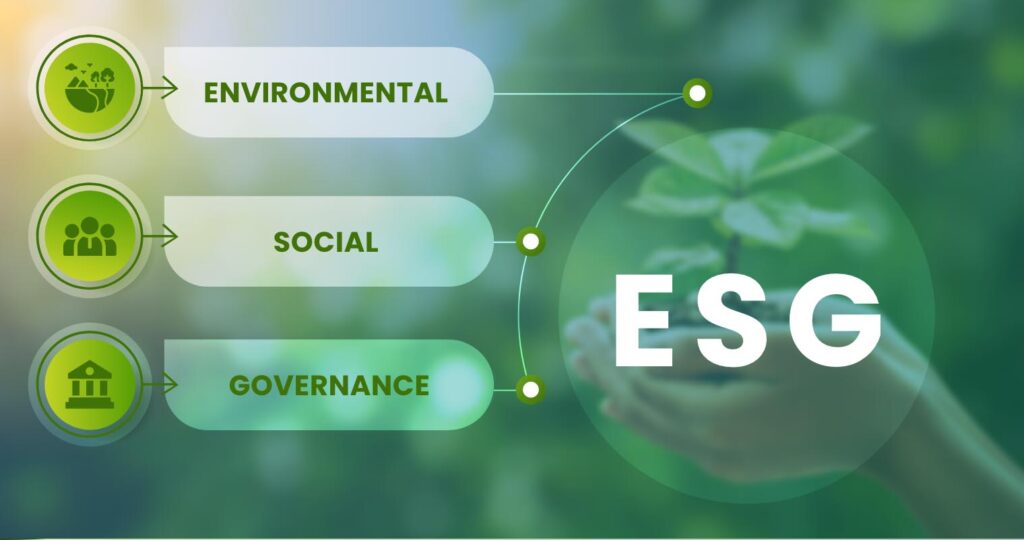ESG (Environmental, Social, and Governance) is a comprehensive framework used to assess how a company addresses critical sustainability and ethical challenges while creating long-term value for stakeholders. Unlike conventional financial metrics—which focus solely on profitability and growth—ESG evaluates non-financial factors that significantly influence a company’s risk profile, operational resilience, and societal impact.
Breakdown of ESG Components
1. Environmental (E)
Focuses on a company’s impact on the planet, including:
- Climate change (carbon emissions, net-zero goals)
- Resource depletion (water usage, energy efficiency)
- Pollution & waste (plastic reduction, circular economy)
- Biodiversity (deforestation, ecosystem protection)
2. Social (S)
Covers how a company interacts with people and communities:
- Human rights (fair labor practices, supply chain ethics)
- Diversity, equity & inclusion (DEI) (gender/racial pay gaps, workplace culture)
- Health & safety (employee working conditions)
- Community impact (philanthropy, local engagement)
3. Governance (G)
Examines corporate leadership and ethical decision-making:
- Board diversity & structure (independent directors, gender balance)
- Executive pay (alignment with ESG performance)
- Transparency & anti-corruption (whistleblower policies, audits)
- Shareholder rights (fair voting systems, investor influence)
Why ESG Matters
-
Investor Demand
-
ESG funds now manage $40+ trillion globally (Bloomberg).
-
Firms with strong ESG ratings often see lower capital costs.
-
-
Regulatory Pressure
-
Laws like the EU’s CSRD and California’s Climate Disclosure Rules mandate ESG reporting.
-
-
Risk Management
-
Poor ESG practices lead to scandals (e.g., oil spills, labor violations) that hurt stock prices.
-
-
Competitive Advantage
-
Consumers (especially Gen Z) prefer sustainable brands.
-
Employees choose companies with ethical values.
-
ESG vs. CSR – Conceptual Difference
| ESG | CSR (Corporate Social Responsibility) |
|---|---|
| Data-driven, measurable metrics | Broader, often voluntary initiatives |
| Used by investors for decisions | Focused on philanthropy & PR |
| Integrated into business strategy | Separate from core operations |
Future Trends in ESG (Environmental, Social, and Governance)
ESG is rapidly evolving, driven by regulatory changes, investor demands, and societal expectations. Here are the key future trends shaping ESG in the coming years:
1. Stricter ESG Regulations & Mandatory Disclosures
- Global standardization: Authorities (EU, US SEC, ISSB) are pushing for unified ESG reporting frameworks (e.g., CSRD, SFDR, SEC Climate Rules).
- Mandatory audits: Companies will face stricter ESG compliance checks, similar to financial audits.
- Greenwashing crackdowns: Regulators will penalize false or exaggerated ESG claims.
2. Climate & Net-Zero Commitments Intensify
- Science-based targets (SBTi): More firms will adopt verified decarbonization plans.
- Carbon pricing expansion: Wider adoption of internal carbon pricing to meet net-zero goals.
- Scope 3 emissions scrutiny: Supply chains will face pressure to reduce indirect emissions.
3. Social Equity & Just Transition Take Center Stage
- Workforce diversity & pay equity: Stricter DEI (Diversity, Equity, Inclusion) reporting requirements.
- Human rights due diligence: Laws like EU’s CSDDD will enforce ethical supply chains.
- Community impact assessments: Companies must prove positive social contributions.
4. AI & Tech-Driven ESG Solutions
- AI for ESG analytics: Machine learning will improve ESG risk assessment and reporting.
- Blockchain for transparency: Supply chain tracking (e.g., ethical sourcing, carbon credits).
- IoT for real-time monitoring: Smart sensors to track emissions, energy use, and waste.
5. Rise of Nature & Biodiversity Reporting
- TNFD (Taskforce on Nature-related Financial Disclosures): New frameworks for biodiversity impact.
- Deforestation-free supply chains: Stricter rules on sourcing (e.g., EUDR).
- Natural capital accounting: Valuing ecosystems in financial terms.
6. ESG-Linked Executive Compensation
- More CEOs’ pay tied to ESG goals: Carbon reduction, diversity metrics, and ethical governance.
- Performance-based ESG bonuses: Investors demand accountability for sustainability targets.
7. Growth of Sustainable & Impact Investing
- ESG ETFs & green bonds: More financial products targeting sustainability.
- Active ownership: Shareholders pushing for ESG resolutions in annual meetings.
- Blended finance: Public-private partnerships for climate and social projects.
8. Circular Economy & Waste Innovation
- Extended Producer Responsibility (EPR): Brands forced to manage product lifecycle waste.
- Plastic tax & recycling mandates: Governments incentivize circular business models.
9. Geopolitical & ESG Risk Integration
- ESG in geopolitical strategy: Companies must navigate climate risks, conflict minerals, and trade policies.
- Resilience planning: Stress-testing for climate disasters and social unrest.
10. ESG Talent & Education Boom
- Chief Sustainability Officer (CSO): More firms hiring dedicated ESG leaders.
- ESG certifications: Growing demand for professionals with CFA ESG, GRI, or SASB training.
Conclusion – The Future of ESG – From Voluntary to Strategic Imperative
ESG is undergoing a fundamental transformation, evolving from a voluntary sustainability initiative into a mandatory, strategic priority deeply embedded in corporate decision-making. Regulatory bodies worldwide—from the EU’s Corporate Sustainability Reporting Directive (CSRD) to the SEC’s climate disclosure rules—are enforcing stricter ESG compliance, making transparent reporting non-negotiable. Investors are also driving this shift, with ESG-integrated assets projected to surpass $50 trillion by 2025, reflecting a broader recognition that sustainability directly impacts financial performance.
Companies leading in ESG are already reaping benefits: lower capital costs, stronger brand loyalty, and enhanced operational resilience. For example, firms with robust climate strategies are better insulated against energy price volatility, while those prioritizing social equity attract top talent and consumer trust. Conversely, businesses that lag face mounting risks—regulatory penalties, investor divestment, and reputational damage from greenwashing accusations.
The next phase of ESG will demand data-driven accountability, with AI and blockchain enabling real-time tracking of carbon footprints and ethical supply chains. Additionally, ESG-linked executive compensation and nature-related financial disclosures (TNFD) will further align corporate incentives with long-term sustainability.
Ultimately, ESG is no longer a side initiative but a core business differentiator. Organizations that embed ESG into their DNA will thrive in an era where stakeholders—governments, investors, employees, and consumers—increasingly equate profitability with responsibility. Those that resist will struggle to survive in a rapidly changing global economy.








Leave a Reply